Indoor plants are a fantastic way to bring nature into your home – especially for those of us living in apartments. However, if you only have a small space, trying to fit pot plants around your furniture can be difficult. It can also be difficult if you have plants that have specific light requirements. This is where hanging plants are the perfect option! You can use a range of different baskets and pair them with stunning trailing plants to create your indoor jungle.
Placing plants around your home can also provide amazing benefits, including cleaning the air you breathe and even promoting better mental health. And indoor hanging plants can create a touch of tropical paradise that can brighten up your home on dreary days. But it can be difficult to decide which plants to use and which plants suit hanging baskets. Today, we are going to show you the 20 best indoor hanging plants!
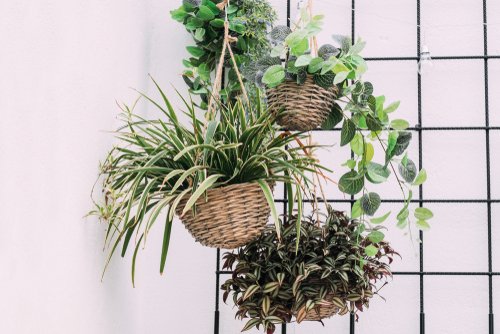
Where to Place Hanging Plants
Many plants used in hanging baskets come from warmer climates, which means that they will need a warmer and more humid atmosphere in bright but not indirect light. And they need to stay warm in winter, above 10-15°C at least, without being placed directly over a heater. Keep them away from draughty windows and invest in a spray bottle so you can spritz your plants and increase the moisture in the air.
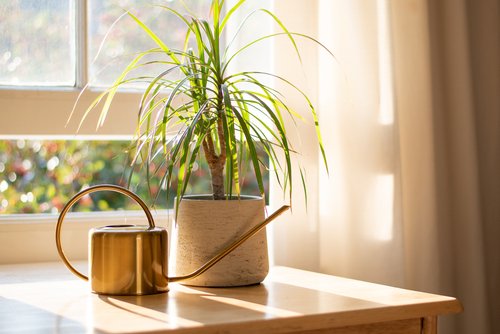 How to Care for Indoor Plants
How to Care for Indoor Plants
No matter if you have one hanging plant or dozens, proper plant care is essential to keep your pot plants thriving.
Potting and Placement
Some plants need a deeper pot or good drainage, which can be tricky with hanging plants. Carefully consider your plant’s needs so you can figure out the best possible for its size, weight, and potting needs.
Light
Light is incredibly important for your plants. Consider the different light areas in your home so you can choose the appropriate plant for each location. This will ensure your plant will flourish, rather than perish.
Soil Needs
Make sure you know what types of soil your plant needs – or lack of soil! Using the proper soil for your plant will ensure it will thrive. Using the wrong soil can result in plants that struggle to grow, sickly plants, and even dying plants.
Consider Your Time Requirements
Look at your lifestyle and how much time you have. If you’re away from home a lot, or you don’t have a lot of time to devote to your plants you need to think carefully about your plants. You may need to limit the amount of plants you have in your home, so you don’t have as many plants to care for. It might also help to choose plants that are low maintenance to suit your busy life.
Who Lives in Your Home?
The people and animals living in your home are also important to consider when choosing hanging plants. Some plants are toxic, so you need to be cautions if you have pets or small children. No matter how high you hang a plant, children and pets can always find a way to get their hands on anything in your home. Best not to take the risk and avoid potentially toxic plants in homes with pets and/or small children.
The 20 Best Indoor Hanging Plants
Below are the best plants we recommend as indoor hanging plants!
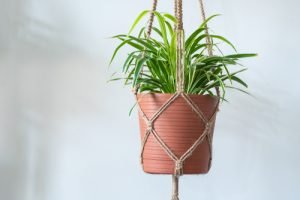
1: Spider Plant
One of the best plants for hanging plants is the spider plant. It has stunning fountains of variegated foliage and little “baby spider” plants that dance around the leaves on curved steams. The spider plant prefers a little shade but is very drought resistant. You can feed it occasionally but it will be quite happy all on its own, with very little pampering compared to other plants.
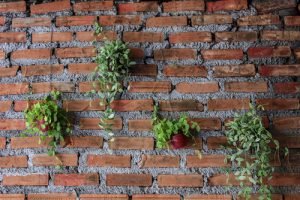
2: Beetle Peperomia
Also known as Peperomia Quadrangularis or Peperomia Angulata has beautifully veined green leaves on stems that dangled down to about half a metre. The leathery leaves are very attractive and it stays compact rather than becoming spindly like other trailing plants? It needs occasionally water and feeding to keep it thriving.
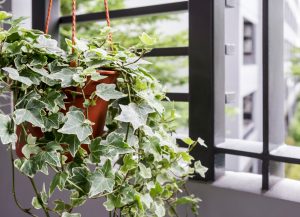
3: English Ivy
This is one of the most common indoor hanging plants and is perfect for beginners. The long trailing leaves are gorgeous and, if used as an indoor plant can also be trained up trellis. It prefers moderate sunlight and does well net to a widow. But it can adapt to slightly shadier conditions. Ensure the soil dries completely in between waterings.
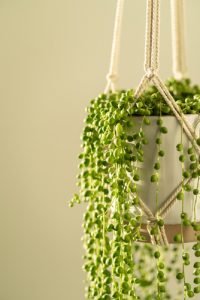
4: String of Beads
Also known as senecio rowleyanus, this plant has fleshy leaves that stud its long, cascading tendrils. It originates from Africa, meaning it prefers a dry atmosphere and is drought tolerant. Don’t mist the plant and let the soil dry completely between waterings. The plant is somewhat toxic, however, as it can give pets and small children a terrible stomach ache if eaten. So if you choose to have this plant in your home, keep it well out of the reach of small children and/or pets.
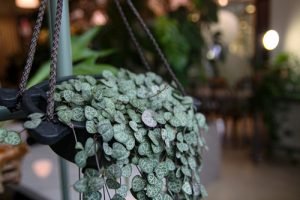
5: String of Hearts
Also known as Ceropegia Woodii, the string of hearts plant is fairly drought tolerant, and good for compact space. It is an evergreen with trailing vines of pink stems and green, heart-shaped, silver-variegated leaves. The string of hearts plant has been known to grow up to 4m in length, so you definitely need to place it in a high position!
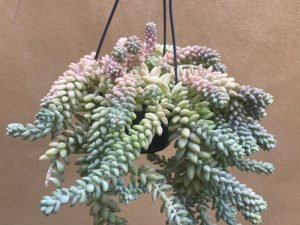
6: Donkey’s Tail
Also known as sedum morganianum or burro’s tail, this is a stunning, hanging succulent that adds an interesting texture to any roomy. It has a pale green colour that is still very on trend. The fleshy green succulent trails over the edge of the basket, looking like the tufted ends of a donkey’s tail, hence the name. It loves lots of bright light and the soil should be left to dry out completely before watering.
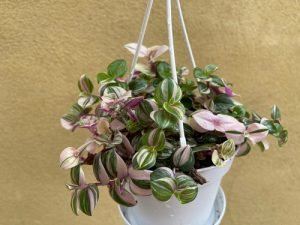
7: Spiderwort
Also known as tradescantia, this is an easy-to-grow plant and a popular choice for hanging houseplants. It has gorgeous leaves that flow out of the hanging basket, with foliage colours ranging from purple, pink, scarlet, white, green, variegated, etc. they don’t need a lot of care, just a good position in a bright spot, out of the sun, and regular watering during the summer.
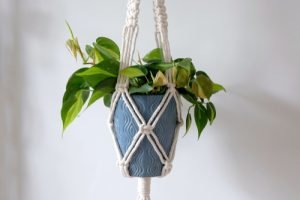
8: Pothos
Pothos goes by many names including epipremnum aureum, Devil’s ivy, and Ceylon creeper, this is a stunning plant that gives rich rewards for very little care. NASA also lists it as one of the few plants that are known for improving indoor air quality. It is a climbing plant, like English Ivy, but can also be grown without support. This allows it to trail its stunning, glossy, yellow-variegated, heart-shaped leave up to 1.8m. it can also tolerate some shade so it is perfect for darker corners, making it ideal for almost any home.
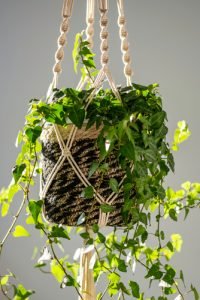
9: Grape Ivy
This pretty plant is actually a member of the grape family, but it looks like other ornamental vines that we group under the name “ivy”. This plant is fantastically suited to indoor hanging plants as it is native to Venezuela. It is tolerant of low light, medium heat, and even low water requirements. The leaves grow in a cascade of vines up to 3m long, meaning you will need to find a high place for this gorgeous plant. And, even better, the leaves get shinier as they grow!
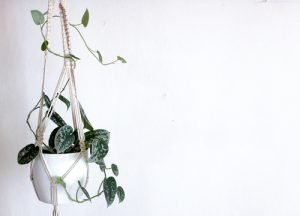
10: Philodendron
The philodendron is another gorgeous, trailing, variegated foliage plant, ideal for indoor hanging plants. Also known as Brasil or the sweetheart vine, it has stunning, large, dark-green leaves with splashes of yellow it can grow to lengths of several metres and grows down like curtains. However, you can keep it trained back with some regular pruning. Remember to wipe the leaves with a damp cloth once in a while to remove the dust and allow your philodendron to better absorb sunlight.
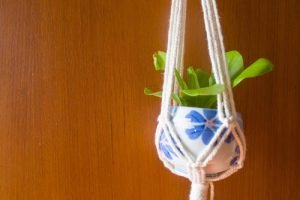
11: Bird’s Nest Fern
The bird’s nest fern has greenery that grows upright, resulting in a planet that looks amazing when hung in a planter. It gives a fantastic illusion of height, and the curled edges gives the plant its quirky character. Because of the upwards-arching growth, the fern makes a lovely option to display in a hanging basket or a cute macrame planter. While this plant doesn’t flower, the pretty rosette shape the way leaves form makes the bird’s nest fern and makes this the perfect, chic addition to your indoor plant collection! The bird’s nest requires bright light and regular watering to thrive.
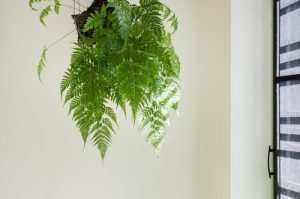
12: Boston Fern
Boston ferns are one of the most common indoor hanging plants. Also known as the sword fern, this plant grow in many tropical areas around the world. The sword-shaped, blue-green fronds have many, tiny leaflets remain evergreen – hence the secondary name “sword fern”. It is a fairly slow grower and is best planted in autumn or spring. They do require a lot of care, however. Boston fern’s need a lot of light as well as humidity, making them ideal for large bathroom hung by the window. Your boston fern will shed dead leaves from time to time, so check them every now and then to see if you need to give them a groom.
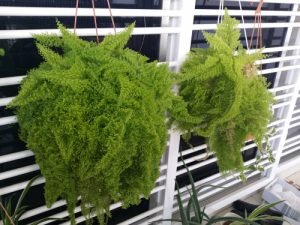
13: Maidenhair Fern
The maidenhair fern is actually the cousin to the boston fern, however it is a more delicate fern that needs far more light and humidity. It has delicate, fan-shaped leaf segments which are typically clustered on wiry black stems. The leaves are smaller than other types of ferns. As well as being on of the most popular indoor hanging plants, it can also be found in nature, growing in rock walls and between rock fissures. Which is why they make perfect hanging plants. Like the boston fern, they are a slow-growing fern, typically taking up to three years to reach their full mature size. It is perfect for sunny bathrooms where the humidity and light can be maintained.
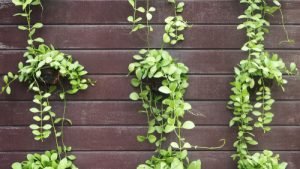
14: String of Nickels
Also know as dischidia nummularia, the string of nickels is an air plant or epiphyte. This basically means that, in its native tropical environment it survives by clinging onto trees and takes moisture and nutrients from the air. The string of nickels has oval, succulent-like leaves that are threaded along wiry stems which grow to 3m long. String of nickels gets its name from the oval, succulent-like leave as the resemble small coins. Their colours can range from green to bronze to silver. Due to its low light needs, growing string of nickels is super easy to grow indoors. They love north, east, or west facing windows under artificial lights. Like the boston fern, it loves humid environments, so kitchens and bathrooms are ideal. It also needs a well-drained, specialist medium, like orchid compost, and it should be misted often.
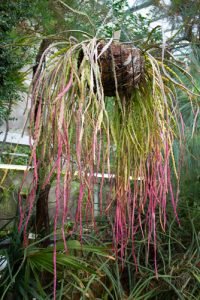
15: Forest Cactus
Also known as the hanging tree cactus or lepismum bolivianum and is also known as a tree hugger. It has strange, spine free, flat and fleshy cascading cactus strands. They even occasionally have white and pink flowers that appear along the stems. Unlike the string of nickels, the forest cactus hates humidity, so don’t spray and be careful how much you water. It isn’t drought resistant, however. So regular watering is essential. Overwatering, however, can cause weak stems and rotted roots. Use a watering can to ensure you don’t overwater your cactus. They also don’t thrive in direct sunlight. Exposure from the afternoon sun can burn the leaves and even turn them yellow or lead to spotting. But without sufficient light the forest cactus’ growth will be stunted and it is unlikely to bloom. It is best placed in an area that catches the morning sun but is in full shade by the afternoon.
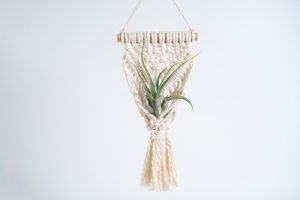
16: Tillandsia
This stunning air plant is incredibly easy to care for, making it perfect for beginner plant owners. Like other air plants, it grows without soil but will still need the occasional spritz of water. It will also need a fair amount of sunlight to thrive. While it won’t trail quite as long as some of the other plants in this list, but it is a bit more unique. Tillandsia are tropical plants called epiphytes, which means they don’t need potting soil and only need minimal care. These air plants have tiny scales on their leaves, known as trichomes, that absorb water and nutrients directly from the air, and even help shade the scorching sun. The roots of the Tillandsia are only used for clinging and do not absorb water and nutrients like other, “earthbound”, plants.
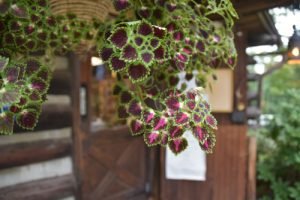
17: Polka Dot Plant
Also known as the begonia maculate, this indoor hanging plant comes with either pink, white, or red spotted leaves. It makes a real statement piece when hung in a room with moderate light. The most common polka dot plant is a pink base with green spots. While these plants are not especially difficult to grow but that are native to warmer climates, so it is important to keep the in warmer parts of your home. It is best to plant them in spring and they stay relatively small when grown in size, even when they mature.
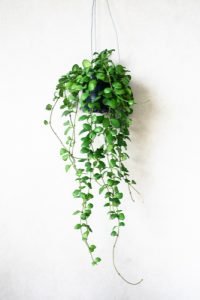
18: Hoya Linearis
The stunning hoya linearis, when well cared for, grows long hanging tendrils of leaves. It is another epiphyte that grows on trees in the Himalayan region in Northern Indian. It actually grows on trees in higher altitudes, dangling down in a similar way to Spanish moss. This plant is different from other hoyas as it doesn’t have the large, firm, waxy leaves the other hoyas. Instead, the leaves are skinny, soft, and slight hair. If you can somewhat replicate its natural habitat, this is a super easy plant to grow. You know your hoya linearis is growing well when it blooms white, star-shaped flowers.
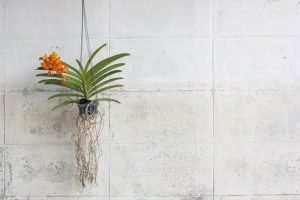
19: Orchid
While orchids might not be the first thing that comes to mind when it comes to indoor hanging plants. But, surprisingly, some look absolutely stunning in hanging baskets, cascading beautifully down the side of the basket. Orchids don’t need to be tucked away in a corner under grow lights or crammed together in the best lit window. Just hang your orchids in an overhead basket and enjoy the cascading orchids with a waterfall of flowers. Hanging baskets are often the best way to grow orchids and, contrary to popular belief, they are that much different to care for. When watered regularly, so the water stays moist (but not soggy), and looked after properly, your orchid will bloom for years.
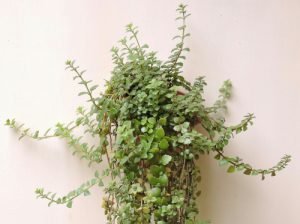
20: Trailing Jade
Also known as peperomia rotundifolia, jade necklace, or creeping buttons this is a stunning tropical perennial plant with soft, trailing stems and small, rounded leaves. This plant is native to South America and has small flowers that grow on the plants tiny little spikes. It makes for the perfect indoor hanging baskets around the house. It prefers bright, indirect light and it can survive an amount of drought. So allow the soil to dry out between waterings then water thoroughly. reduce watering in winter. And it is on-toxic to pets and people, making a perfectly safe indoor hanging plant for your home!
Looking to add a stunning indoor hanging basket or two to your home? Come visit your local Aumanns Nursery & Garden Supplies and chat with one of our amazing team members. We can help you find the perfect plant for your home and lifestyle!

